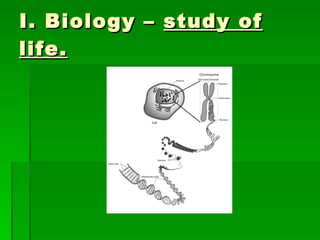Chapter 1 notes
- 1. CHAPTER 1 NOTES “ BIOLOGY AND YOU”
- 2. I. Biology – study of life.
- 3. II. Organism – any living thing.
- 4. III. CHARACTERISTICS OF LIFE
- 5. All living things are made of cells 2. All living things grow and develop . 3. All living things obtain and use energy to run life processes . (metabolism) 4. All living things respond to changes in their external environment. a. Homeostasis – maintenance of stable internal environment by the cells. 5. All living things can reproduce .
- 6. IV. BIOLOGY IN YOUR WORLD
- 7. 1. Scientists are using biology to help solve the problems of today. Preserving our environment.
- 8. Improving the food supply
- 9. Understanding the human genome
- 10. Fighting diseases such as cancer, AIDS, and genetic diseases.
- 12. Observation is the basis for scientific research. 2. Stages of the scientific method: a. Observing the world around you b. Asking questions c. Propose a hypothesis – a possible explanation for a problem. d. Perform an experiment , a planned procedure to test a hypothesis. e. Draw a conclusion that supports or rejects the hypothesis
- 13. Parts of an experiment: (Ex: see if plants grow better if they are given fertilizer) a. Control group – the group in the experiment that receives no experimental treatment. (one plant that gets no fertilizer) b. Experimental group – the group in the experiment that receives some type of experimental treatment. (one plant that gets the fertilizer.) 1. independent variable – factor that is changed in an experiment. (fertilizer) 2. dependent variable – variable that is measured in an experiment. (height of the plant)
- 14. 4. Theory – formed when repeated experiments confirm a hypothesis over and over again. A theory unites and explains a broad range of observations.













